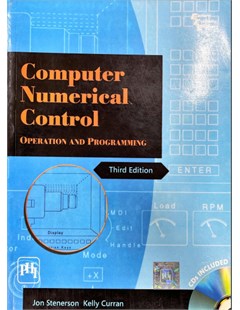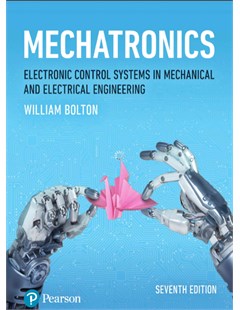Computer numerical control: Operation and programming
Reflecting manufacturers' growing need to integrate computers into their production processes, this book covers the machining fundamentals--as well as Computer Numerical Control programming and operation of Computer Numerical Control (CNC) machine tools.
2009
Reflecting manufacturers' growing need to integrate computers into their production processes, this book covers the machining fundamentals--as well as Computer Numerical Control programming and operation of Computer Numerical Control (CNC) machine tools. Its focus is based on the authors' many years of teaching experience along with industrial CNC courses at various businesses and industries. Material is presented in a logical, easy-to-understand fashion, to help readers overcome some of the anxiety that has been associated with the subject. Covers the machining fundamentals--as well as Computer Numerical Control programming and operation of Computer Numerical Control (CNC) machine tools. Critical topics discussed include comprehensive carbide tooling information, basics of CNC electrical discharge machining, and a CAD/CAM overview. A review of basic right triangle trigonometry emphasizes an important area of understanding for future operators and programmers of CNC equipment. Also features tutorials for Mazak, Bridgeport Ezpath, and Fanuc (FAPT) programming. For future operators and programmers of CNC equipment.
The third edition is organized into 3 sections: G-Code Programming, Conversational Programming, and Quality.
Section I - G Code Programming
Chapter 1 is an introduction to computer numerical control. It examines the history of CNC, types of CNC machines, components of CNC machines, and the Cartesian coordinate system, absolute and incremental positioning. It provides the foundation for CNC programming.
Chapter 2 provides an easy to understand chapter on trigonometry. It provides the reader with a practical approach to using trigonometry to calculate missing information on blueprints so that programs can be written.
Chapter 3 covers carbide cutting technology. Machinists need a good understanding of the proper use of carbide tooling to be productive. They need an understanding of available tooling technology and the speeds and feeds required to make carbide efficient. The chapter also covers tool geometry and selection.
Chapter 4 covers the fundamentals of programming. This chapter has been improved through a more step-by-step approach to programming and extensive questions and exercises that lead the reader through simple examples to understand basic programming and develop simple CNC code.
Chapter 5 is a completely new chapter. It builds upon what the reader learned in the previous chapter through the use of CNC program examples. Each of the programs are thoroughly explained in line-by-line- fashion to lead the reader through all of the important aspects of programming.
Chapter 6 is a new chapter that examines work holding for machining centers. It also covers proper setup procedures and tooling for machining centers.
Chapter 7 covers the fundamentals of machining centers. It covers types, components, tooling, and operation of machining centers.
Chapter 8 covers programming machining centers. This chapter builds upon the previous programming chapters and adds material on the use of canned cycles to ease program development.
Chapter 9 covers the fundamentals of CNC turning centers. Types of CNC turning centers, components of a typical turning center, axes of motion, work holding, tooling, and operation are covered.
Chapter 10 examines programming CNC turning centers. Material has been added and modified to make it easier to understand tool and work offsets. The chapter leads the reader through examples to illustrate the use of all common turning codes and canned cycles.
Chapter 11 covers Electrical Discharge Machining. This chapter is missing in most CNC texts. This chapter explains the technology and components and then leads the reader through programming examples.
Chapter 12 is a new chapter on abrasive waterjet and laser cutting. These technologies are dramatically changing the way industry makes parts. They can be used to make pre-machined part blanks to reduce machining time. They can also completely eliminate further machining in many cases because of their ability to produce good surface finishes and hold tight tolerances. Shops that do not presently have these technologies should be examining them for their ability to dramatically increase productivity.
Chapter 13 is a basic introduction to the fundamentals of CAD/CAM. It is intended to give the reader a fundamental understanding of how CAD and CAM can be used and integrated to provide the information needed for CNC part programs.
Section II - Conversational Programming.
Chapter 14 covers programming a Mazak machining center in conversational programming. It leads the reader through in step-by-step programming of Mazak conversational language.
Chapter 15 covers programming a Fanuc turning center in conversational programming. It leads the reader through in step-by-step programming of Fanuc conversational language.
Section III - Quality
Chapter 16 examines the fundamentals of statistical process control. This chapter will help the reader understand the importance of statistical thought in process control and improvement. Quality improvement is vital if we are to compete in a world economy.
Chapter 17 leads the reader through the development and use of process control charts. These can be sued to ensure that processes are running optimally. They can also be sued to indicate when a process goes out of statistical control. The sue of statistical thought and charts can dramatically reduce part variation and improve quality while, at the same time, reducing the cost of quality.
Chapter 18 examines ISO 9000 quality systems. This chapter has been rewritten to reflect the new standard. Employees need to have a good understanding of the standard and its intent to appreciate the benefits that can come from a good quality business system.
Jon Stenerson Kelly Curran. Computer numerical control: Operation and programming. USA. PHI Learning Private Limited,2009.
Ngành CÔNG NGHỆ KỸ THUẬT CƠ ĐIỆN TỬ (7510203)
 |  |  |
| Mobile Robots: Navigation, Control and Sensing Surface Robots and AUVs | Mechatronics Electronic Control System In Mechanical and Electrical Engineering |
Thứ Ba, 15:36 08/02/2022
Copyright © 2018 Hanoi University of Industry.